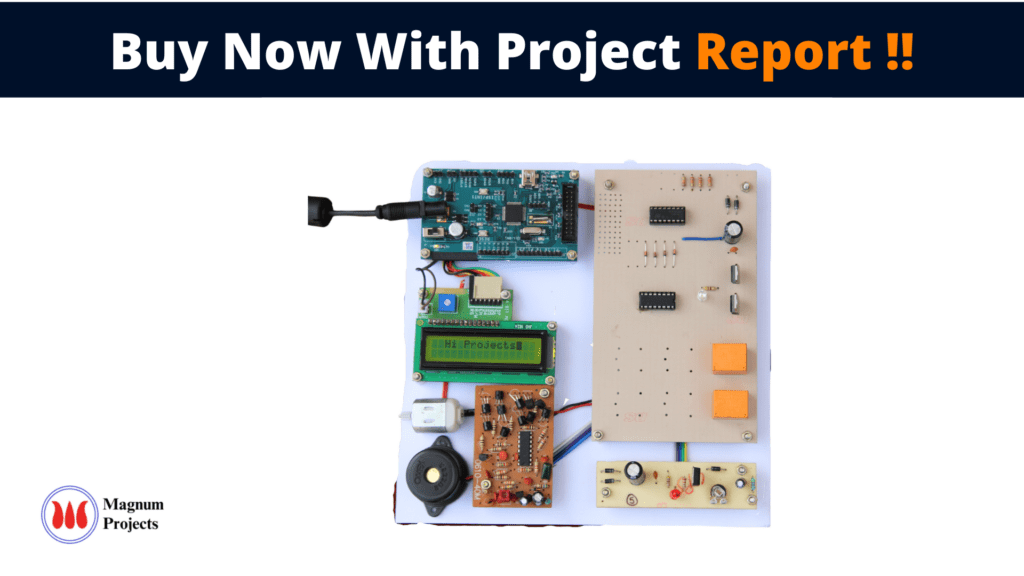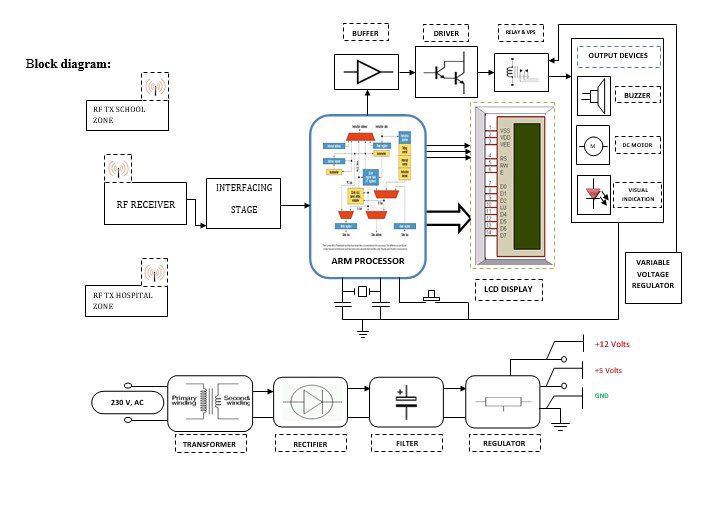Table of Contents
Introduction:

The project presented here is a novel approach to vehicle navigation & safety implementation. As the title suggests, the project is aimed at automatically sensing the areas/zones like “School Zone”, and “Hospital zone”.
In convention, these special zones or areas are indicated at the roadside on a pillar or road sign pole.
As an example, near the school zone, the sign board displays “School Zone Ahead, Drive Slowly”, or near a hospital, “Hospital Area-Do not Blow Horn”, but in reality rarely this practices. Drivers go at very high speeds as usual near the school zone or operate the harsh horns loudly causing inconvenience to the patients in the hospital.
Even though these are meant for the safety of the vehicles traveling and also for the general public, it is hardly practiced by vehicle drivers. As a result, making the whole concept of displaying warning signs and messages on the roadside boards is meaningless.
To provide a better alternative, one can develop a system that will automatically sense such traffic signs automatically and accordingly inform the drivers and also assist them in controlling the vehicle voluntarily or forcibly. All in all, resulting in a very effective and fail-proof system to provide traffic regulation, safety, and convenience to the people.
As the whole project is not just limited to these few functions, this project can be made mandatory. That way one can provide a more reliable security device and streamline traffic flow. A few additional features which can be integrated with this system are, “Down Hill Detection”, “Auto-Breaking with Obstacle Detection” “Auto Speed limit Sensor” etc.
As the design of this system goes, the project proposed here consists of a set of units
Zone / Area Unit
Vehicle Unit

Block diagram explanation:
Power supply unit:
This section needs two voltages viz., +12 V & +5 V, as working voltages. Hence specially designed power supply is constructed to get regulated power supplies.
ARM:
ARM is a computer processor-based RISC architecture. A RISC-based computer design approach means ARM processors require significantly fewer transistors than typical processors in average computers. This approach reduces costs, heat, and power use. The low power consumption of ARM processors has made them very popular:
The ARM architecture (32-bit) is the most widely used in mobile devices, and the most popular 32-bit one in embedded systems.
ARM processor features include:
- Load/store architecture.
- An orthogonal instruction set.
- Mostly single-cycle execution.
- A 16×32-bit register
- Enhanced power-saving design.
RF transmitter:
This is a 4-channel Radio Frequency Transmitter specially tuned with its RF Receiver part in carrier frequency. Each zone is set with one channel and transmits its presence to the moving vehicle’s RF Receiver unit.
RF receiver:
This is also a 4-channel RF Receiver specially tuned with its counterpart RF Transmitter in carrier frequency. When the vehicle enters any zone that zones RF signals are received by this unit. Thus depending upon the channel signals it receives from the transmitting end the channel output of the RF Receiver goes HIGH. This HIGH signal is fed to the MSP chip through Buffer & Driver and Switching stage for further processing.
Buffers
Buffers do not affect the logical state of a digital signal (i.e. a logic 1 input results in a logic 1 output whereas logic 0 input results in a logic 0 output). Buffers are normally used to provide extra current drive at the output but can also be used to regularize the logic present at an interface.
Drivers
This section is used to drive the relay where the output is the complement of input which is applied to the drive but the current will be amplified.
Relays
It is an electromagnetic device that is used to drive the load connected across the relay and the o/p of the relay can be connected to the controller or load for further processing.
Methodology:
This System Smart Zone Sensing With Auto Breaking System Using an Arm system works like this. Each monitoring zones are fitted with RF Transmitter units with a unique Identity Code. All the vehicles must be fitted with RF receivers and respective circuitry on their vehicle’s number plate. The display will be fitted on the dashboard for a visual representation of the alert messages sent by respective zone Transmitters.
When a vehicle with 70 Kmph speed enters the school Zone, it receives the alert message ” School zone, Please go slowly. Speed limit is 30 Kmph”. Also, the receiver checks the speed limit of the vehicle and found above 30 kmph then reduces it until crosses the School zone area. Similarly, if the vehicle is in the hospital zone then the horn blows slowly.
Advantages:
- This application is very useful for any kind of vehicle.
- This application is easy to install and easy to operate.
- Manpower can be saved by implementing auto-detecting circuits.
- More reliable than manual Operation.
Disadvantages:
- One-time investment cost
Applications:
1. The project is used to secure and avoid road accidents.
2. It can be used as part of the automation of s or Public Transportation.
3. This system is used to trace the culprit vehicles by police persons.
4. This system can be used for ‘timekeeping’ purposes in public transportation, such as departure & arrival timings, the number of rotations each vehicle turned, etc.




